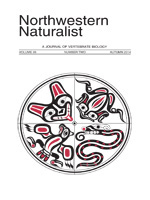Common Ravens (Corvus corax) and American Crows (C. brachyrhynchos) are important predators of eggs and chicks of the Snowy Plover (Charadrius nivosus), which compromises population recovery of this federally listed species. We used a before-after, control-impact experiment over a 4-d interval to examine changes in corvid occurrence within 1, 10, and 50 m of a feeding area in response to scare tactics and corvid effigies, a non-lethal predator control method. We conducted our study during September–February at Clam Beach, California, where corvids are abundant and plovers experience high reproductive failure compared with other sites in northern California. On Day 1, food and trash attracted corvids within 1–2 h after sunrise, suggesting that some individuals frequented beaches to scavenge for food left by humans. On Days 2 through 4, effigies significantly reduced average corvid abundance and incidence (percentage of observations with at least 1 corvid present), but the effect was only significant within the 50-m zone. In all cases, however, some, albeit fewer, corvids continued to occur on plots with effigies, suggesting that their effectiveness as a deterrent of corvids near plover nests during the breeding season is limited.
How to translate text using browser tools
29 July 2014
Experimental Evidence That Scare Tactics and Effigies Reduce Corvid Occurrence
Sara A Peterson,
Mark A Colwell
ACCESS THE FULL ARTICLE

Northwestern Naturalist
Vol. 95 • No. 2
Autumn 2014
Vol. 95 • No. 2
Autumn 2014
American Crow
Common Raven
corvids
effigy
non-lethal
predator management
Snowy Plover




